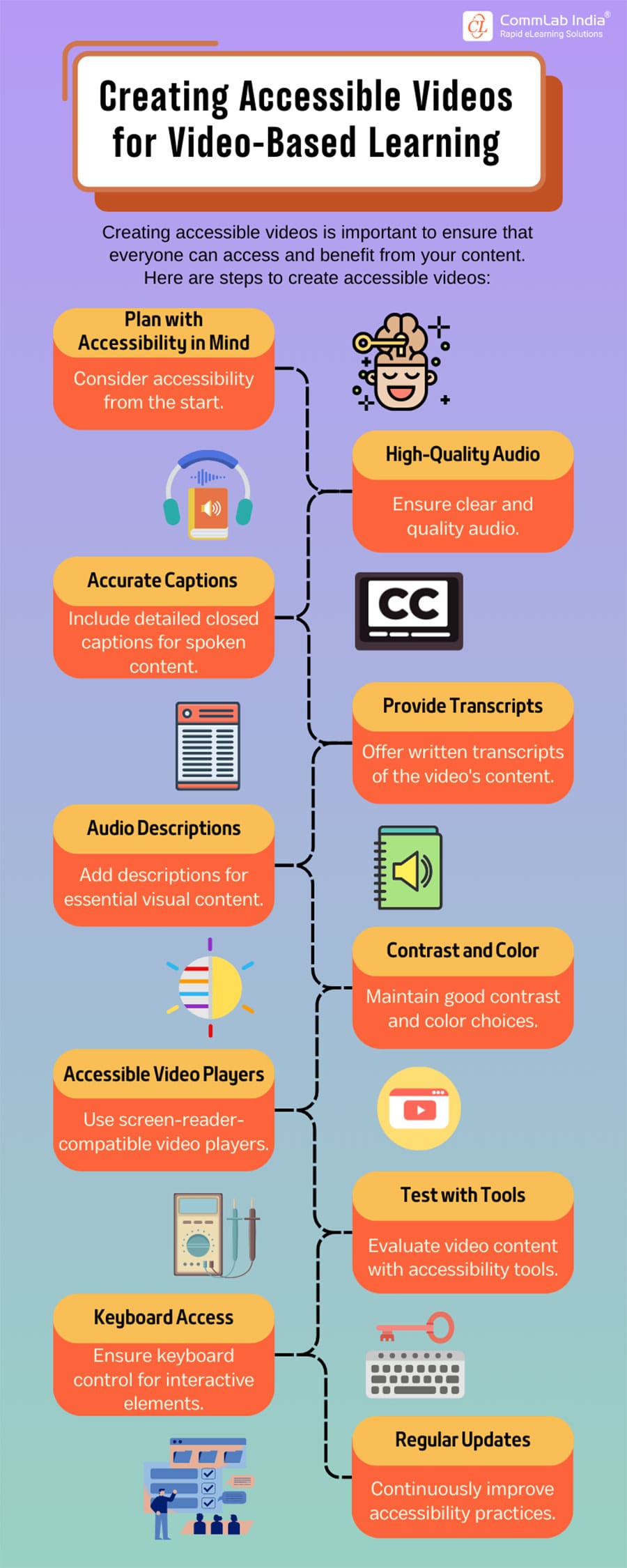Creating Accessibility in Video-based Learning, What’s the Need? [Infographic]
![Creating Accessibility in Video-based Learning, What’s the Need? [Infographic] Creating Accessibility in Video-based Learning, What’s the Need? [Infographic]](https://blog.commlabindia.com/hubfs/blogs/video-based-learning-creating-accessibility-infographic.jpg)
Imagine a scenario where a visually impaired learner can seamlessly access video-based learning materials through screen readers or a learner with hearing difficulties can follow the content effortlessly with the support of captions. That creates an accessible learning environment. Isn’t it?
A Training Industry Report found that only 36% of businesses have a top-down commitment to developing accessible digital learning experiences. Isn't it past time for L&D leaders to do more to ensure that everyone can reap the benefits of easily accessible learning content?
Today, ensuring accessibility in online learning is more than just a matter of compliance; it is a fundamental commitment to providing equal learning opportunities. With a more diverse audience, accessibility features are becoming increasingly important for accommodating different learning styles and meeting the needs of learners with disabilities.
Understanding Accessibility in Video-based Learning and Its Role in Creating an Inclusive Workplace
As a diverse workforce becomes the norm, catering to various learning needs becomes essential. Accessible video-based learning accommodates individuals with different abilities, ensuring that everyone, including those with disabilities, can fully engage with the content.
Moreover, accessible learning aligns with legal and ethical considerations, promoting a fair and supportive learning environment. Accessibility means making content usable for everyone, including individuals with disabilities. In video-based learning, this involves incorporating features such as closed captions, transcripts, customizable playback options, audio descriptions, and more.
→ Download Now: Video-based Learning [Infographic]
By prioritizing accessibility, organizations demonstrate a commitment to equal opportunities for learning. This approach not only aligns with legal requirements but also reflects a broader understanding of diversity in the workforce. Accelerating efforts to create accessible video-based learning not only benefits individuals with specific needs but also enhances the overall quality and reach of training initiatives, fostering a culture of diversity and inclusivity within the organization. Following are some interesting benefits of creating accessible videos in video-based learning.
1. Inclusive Learning Experience
Accessible videos cater to diverse learning needs, accommodating individuals with disabilities and ensuring that everyone, regardless of their abilities, can engage with the content.
2. Compliance with Regulations
Ensuring videos are accessible helps organizations comply with mandated accessibility regulations, avoiding legal issues and fostering a responsible corporate training environment.
3. Improved Understanding
Features like closed captions and transcripts aid comprehension, providing additional support for learners. This is particularly beneficial in scenarios where English might not be the first language or for individuals who prefer reading alongside listening.
4.Flexibility for Various Learning Styles
Accessible videos provide flexibility, allowing learners to choose how they consume content. Visual learners may benefit from transcripts, while auditory learners can focus on audio elements, catering to a spectrum of learning preferences.
5. Positive Corporate Image
Prioritizing accessibility in corporate training demonstrates a commitment to diversity and inclusivity. This not only aligns with ethical considerations but also enhances the organization's reputation as a socially responsible entity.
Why Should Organizations Accelerate Designing Accessible Video-based Learning?
Final Thoughts
Investing in accessible features for corporate training videos not only ensures compliance with inclusivity standards but also cultivates a richer learning experience. It's an investment to foster a more inclusive and diverse learning environment. To know more about designing effective video-based learning experiences, download our infographic to get a bird’s eye view!




![Video-based Learning — The Go-to Strategy for Modern Learners [Infographic]](https://no-cache.hubspot.com/cta/default/59327/01a6bcb1-79c8-44e5-ade9-be0c530d9ae3.png)

![Mobile Learning Delivery Options for Anywhere Learning! [Infographic]](https://blog.commlabindia.com/hubfs/Imported_Blog_Media/mobile-learning-delivery-options-infographic1.jpg)
